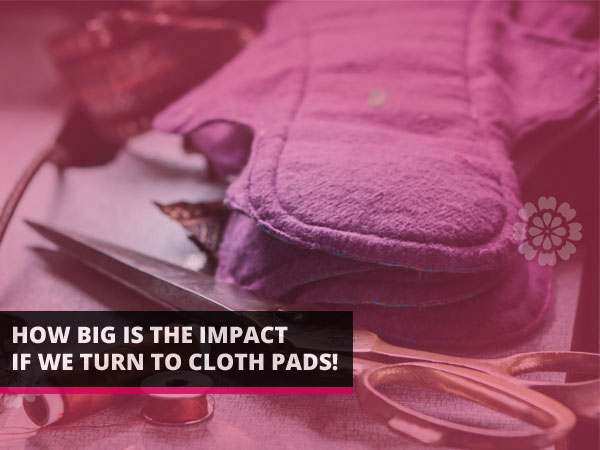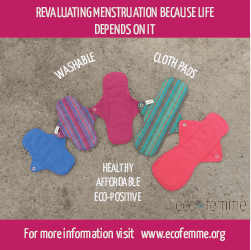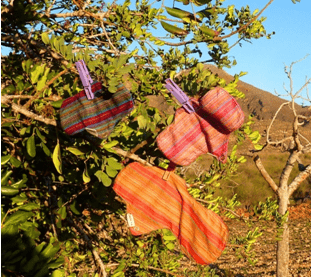Traditionally, women all over the world have used cloth to handle their monthly menstrual flow. These days, however, disposable menstrual products such as pads and tampons are more commonly used around the world. Promoted for their convenience, absorption capacity; these products are interpreted as a step towards women’s liberation and modernity and a step towards carefree periods. However, disposable menstrual products come with immense health and environmental issues.
What are some of the health issues for women who use disposable menstrual products?
Your skin is the largest organ in your body and also the thinnest. Less than 1/10th of an inch separates your blood stream from potential toxins. Also, your skin is highly permeable, especially the skin around your vaginal area and inside your vagina itself. This means that anything your skin comes into contact with can enter your bloodstream in less than 30 seconds and be distributed throughout your body. Once these chemicals find their way into your body,
they tend to accumulate over time. This is why attention needs to be paid to the ingredients used in tampons and sanitary pads. Most pads have a top layer that feels like cloth but is in fact a plastic woven sheet, plastic wings and adhesives and super-absorbent polymer gels—that soak up the flow—are comprised of plastics; most tampon brands come with plastic applicators and are made of non-organic cotton.
- Residual pesticides – Most major brands of tampons and pads commonly contain non organic cotton or wood pulp grown using agrochemicals and pesticides.
- Most pads have a top layer that feels like cloth but is in fact a plastic woven sheet, plastic wings and adhesives and Super-absorbent polymer gels—that soak up the flow—are comprised of plastics; most tampon brands come with plastic applicators…not to mention the wrappers! Research has shown that each conventional sanitary pad contains the equivalent of about four plastic bags!
- The call for further research to reduce on health risks to women from dioxin and other chemicals has been raised in the US Tampon Safety Act and Robin Danielson Act since 1999(1). The US Endometriosis Association indicated to use organic cotton sanitary products without plastics until research addresses the risks(2).
- Bacteria and fungus toxins – Using the same pad for hours containing synthetic materials also restrict the free flow of air, can trap heat and dampness, potentially promoting the growth of yeast and bacteria in your vaginal area, a possible cause for vaginitis(3).
What are the environmental costs?
1. Sanitary waste is HUGE – The products we use add up. If only a quarter of India’s menstruating adolescent girls alone used disposable pads, 90 million would be disposed or burned every month alone.
2. There is no ‘away’ – The plastics and components as well as the wrappers of disposable products are largely non-biodegradable, presenting huge waste management challenges around the world. Research has shown that each conventional sanitary pad contains the equivalent of about four plastic bags! A single pad is estimated to take 500-800 years to decompose in landfill. When pads are flushed down the toilet, sanitation workers have to descend into manholes to remove and handle used menstrual products from sewer blockages, public toilets, household trash, or even the roadside. These tasks are often done without protective clothing, gloves or masks. which puts the workers at risk of contracting infections with potentially deadly viruses or diseases.
3. Burning releases environmental toxins – In many parts of the world, disposable menstrual products are burned by individuals or in incinerators along with other waste; this causes dioxins and other chemicals to be released which creates toxic ash and fumes. Read more about incineration here.
What are the alternatives?
Cloth washable pads and menstrual cups are safe, hygienic and environmentally friendly alternatives to disposable menstrual products.
Eco Femme cloth pads are made of cotton flannel with a thin layer of leakproofing PUL on the bottom layer to ensure a safe feeling.
Cloth pads do not contact the skin with any plastics and therefore eliminate the risk of exposure to its potentially hazardous substances like dioxins, BPA, etc. When cloth pads are washed well, dried in direct sunlight and stored properly, they are perfectly hygienic.
Cloth pads are also a great option to reduce the monthly cost a woman spends on menstrual products. Our pads are washable and reusable for 3+ years. This means, that while a woman will be spending on average 2520 rupees on disposables for this time period, the cost for the cloth pads will come down to 945 rupees.
For more information visit: www.ecofemme.org
Find the article on Eco-femme Blog here.
Sources
(1)GovTrack.us: H.R. 2332 (112th): Robin Danielson Act
(2)Endometriosis Association: Endometriosis & Dioxins
(3)CMAJ JAMC: Contact Dermatitis Associated With the Use of Always Sanitary Napkins
Additional Sources
(2)World Health Organization: Dioxins and Their Effects on Human Health
(3)Endometriosis Association: Endometriosis & Dioxins
(4)http://articles.mercola.com/sites/articles/archive/2013/05/22/feminine-hygiene-products.aspx
Disclaimer: The views expressed in this article are that of Eco Femme and may not necessarily reflect the views of OoWomaniya.
This Article is Powered by Ecofemme – The Cloth Pad Revolution
Have queries related to your Periods? Ask here –










,